Abstract
Background/Objective:
The study's objective was to determine the efficacy of guided internet-assisted intervention (GIAI) on depression reduction among educational technology students of Nigerian universities.
Methods:
The design of the study was a 10-weeks group-randomized trial (GRT) which involved a pre-test, post-test, and follow-up assessment. A total of 192 educational technology students who were identified as having depression formed the sample of the study. Beck's Depression Inventory-II (BDI-II) was the measure used for data collection in the study. Data collected were analyzed using ANOVA with repeated measures.
Results:
The initial assessment results showed that the participants in both treatment and usual-care control groups had depression. After 10-weeks participation in GIAI, the assessment results showed a significant reduction in depression among students in the treatment group when compared to those in the usual-care control group. The follow-up assessment indicated a further significant reduction in the depression among participants in the treatment group when compared to those in the usual-care control group.
Conclusion:
The authors concluded that GIAI was significantly effective in reducing depression among university students in the treatment group compared to those in the usual-care control group. Therefore, educational technologists, counselors, psychologists, health workers, and other social workers should adopt educational intervention using GIAI in helping university students undergo depression reduction.
Keywords: depression reduction, educational technology students, guided internet-assisted intervention, Nigerian universities
1. Introduction
The prevalence of depression among university students is increasing. As observed by Ibrahim et al,[1] depression is a common health problem that ranked third after cardiac and respiratory diseases, and university students are at higher risk of it. In a study by Dahlin et al,[2] it was observed that the prevalence of depressive symptoms among students was 12.9%, significantly higher than in the general population, out of which 2.7% of students had attempted to commit suicide. Shamsuddin et al[3] found that in a study with university students, 27.5% of the students had moderate, and 9.7% had severe or extremely severe depression. A recent study in south-east Nigeria showed that a surveyed sample of students (97.3%) had severe depression.[4] The authors noted that university students face challenges related to independent living and academics which predispose them to severe depression. Other studies confirmed a severe rate of depression among university students.[5–8] Thus, depressive symptoms among university students became a significant and emergent public health concern for which efficient intervention is needed.[9–12]
There is evidence that depressed university students are reluctant to seek intervention due to difficulties in attending therapy during usual school hours, financial constraints, lack of motivation, and the predicted waiting period toward intervention.[13] Thus, evidence-based intervention, usually conducted on a face-to-face basis, has limitations and gaps in depression treatment literature. However, there is evidence that internet-assisted interventions may lead to clinically relevant changes among depressed individuals.[8] To fill the existing gap between needs and provision of face-to-face treatment, internet-assisted interventions are encouraged. Literature shows the treatment gap between available depression interventions and individuals benefiting from such interventions.[13–15] Moreover, an extensive variety of internet interventions have been previously developed for reducing symptoms of depression among individuals of some populations,[13,16] except educational technology students of Nigerian universities. Meanwhile, educational technology students of Nigerian universities may prefer internet-based intervention because the internet is part of their curriculum.[17–19]
Study[13] further confirm that there may be small-to-medium effect sizes when internet-assisted interventions are delivered as stand-alone self-help interventions, but medium-to-large effect sizes when delivered as therapist-guided interventions. Hence, an internet-based intervention may be more efficacious when it is guided by therapists. But previous studies have failed to explain whether the Guided Internet-Assisted Intervention (GIAI) will be efficacious on depression reduction among educational technology students of Nigerian universities. Therefore, the objective of the study was to determine the efficacy of GIAI on depression reduction among educational technology students of Nigerian universities. The hypothesis that GIAI will be efficacious on depression reduction was tested. Given that self-defeating life patterns, irrational thinking patterns, negative feelings, maladaptive behaviors, and ignorance may cause depression,[6,20–22] GIAI adopted the principle of internet-based cognitive behavior therapy (ICBT) used in previous studies.[23,24]
2. Method
2.1. Ethical consideration
This study was approved by the Research and Ethics committee of the Department of Art Education, University of Nigeria, Nsukka. Informed written consent was obtained from all the study participants through email, after explaining to them the purpose and procedure of the study. It was clearly explained that participants can withdraw from the study willingly at any point in the study. Besides, the confidentiality of students’ responses and data was maintained. Again, the research procedure of this study was designed in line with the ethical standards of the institutional and national research committee, as in the previous study.[25]
2.2. Study design
The design of the study is a 10-week group-randomized trial (GRT) which involved a pre-test, post-test, and follow-up assessment. Using the GRT design, the authors of the current study used groups to serve as the primary sampling unit in the selection process. The groups were randomized into 2 arms, and then responses were measured on individuals within those groups.[26] According to Lee et al,[26] GRT has become a standard study design to assess the effect of a clinical intervention program for disease prevention.
2.3. Inclusion and exclusion criteria
Inclusion criteria included having depression, being an educational technology student of a Nigerian Federal University, not being currently in any depression intervention or psychotherapy, having a laptop, iPhone, tablet, or smartphone that accesses the internet, and being willing to sign informed consent to participate in the study. The authors also set the exclusion criteria to include having the presence of bipolar or psychotic subtypes of depression, panic disorder, current substance abuse, past or present schizophrenia, organic brain syndrome, being currently in educational intervention, psychotherapy, psychotropic medication or hospitalization for psychosis, or risk of imminent suicide, as in previous study.[6] The criteria were determined by the therapists through self-report by the participants via email and confidential telephone calls, following internet intervention guidelines.[27]
2.4. Study participants
Six hundred eighty potential participants were recruited through federal university students’ portals in Nigeria, but 192 students met the inclusion criteria. The demographic characteristics of the eligible students are shown in Table 1. The adequacy of the sample size was determined using G∗Power 3.1 software.[28] Before the end of the study, 78 participants dropped out, giving a missing data value of about 41%. See the participants’ flow diagram (Fig. 1).
Table 1.
Participant demographics.
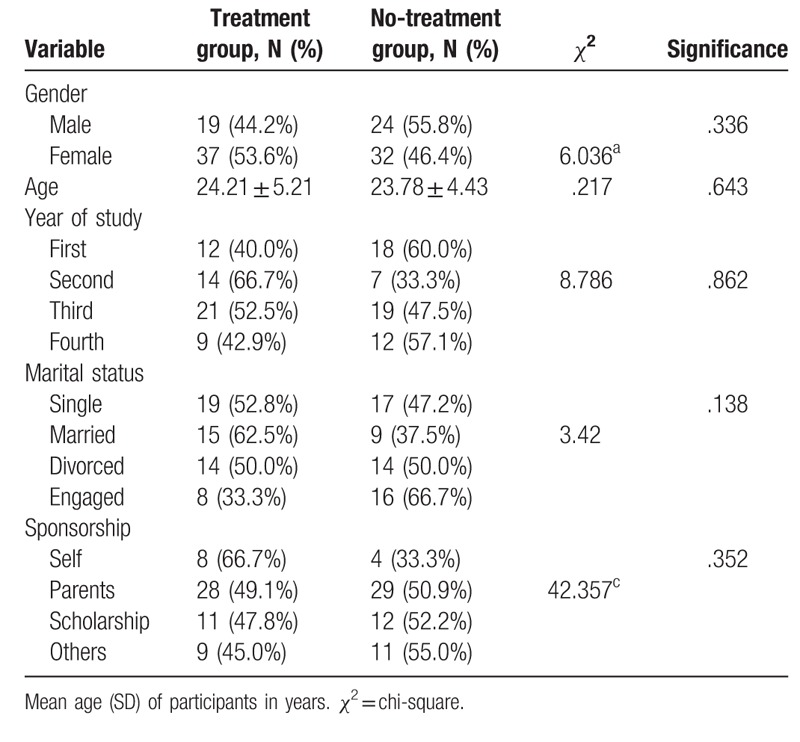
Figure 1.
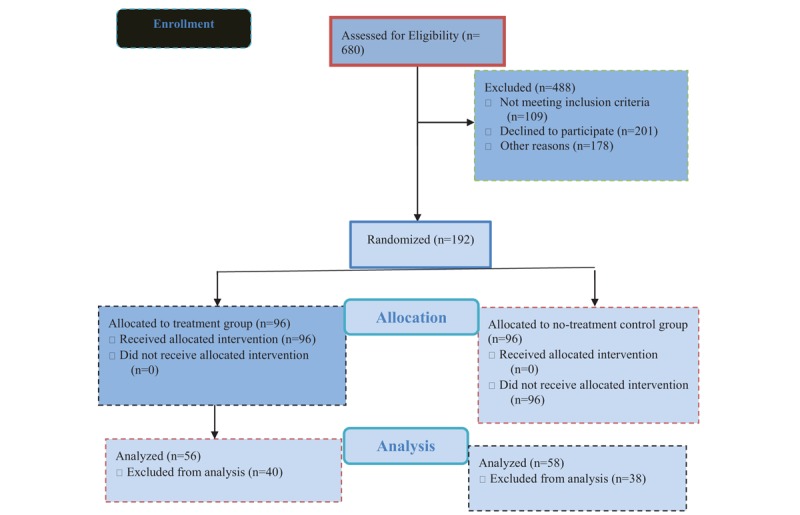
Flow diagram: This legend shows the distribution of participants into the treatment and control groups.
2.5. Measure
Beck's Depression Inventory-II (BDI-II). The BDI-II contains 21 items that assess the incidence and severity of the symptoms of depression.[20,21,29] The items of BDI-II are categorized into affective (8 items) and somatic (13 items) subscales. The scoring value of BDI-II is a 4-point scale of 0 to 3 arranged in increasing severity about a particular symptom of depression. Also, 21 items were selected based on depressive symptoms described in DSM-IV criteria. Based on previous studies,[6] the benchmark used in the interpretation of scores in the BDI-II ranges from 0 to 13 = minimal depression; 14 to 19 = mild depression; 20 to 28 = moderate depression; and 29 to 63 = severe depression. The internal reliability consistency of the BDI-II in a previous study,[6] was 0.89 alpha while in the current study, the internal reliability consistency was 0.91 alpha.
2.6. Procedure
The study comprised of 2 groups: the treatment group and the usual-care control group. Each of the groups made up of 96 participants who were randomly allocated, following a sequence generated by computer allocation software.[30] A baseline assessment (Time 1) was conducted in the 2 groups before the intervention through email messages. Participants in the treatment group were allowed to attend a 10-week GIAI while the participants in the usual-care control group were free to have their usual care. Thereafter, a post-intervention assessment (Time 2) was conducted in the treatment group and the usual-care control group via email. After 4 weeks, a follow-up assessment (Time 3) was conducted in both the treatment group and the usual-care control group via email. The 3 sets of data – Time 1, Time 2, and Time 3 were subjected to analysis to determine the outcome of the study. The data analysists were all experts in clinical data analysis and interpretation.
2.7. Intervention
2.7.1. Guided internet-assisted intervention
Guided internet-assisted intervention is a structured and standardized intervention delivered through the internet. The researchers of the current study developed the GIAI following guidelines for internet interventions[27] and internet-administered depression intervention protocol.[31] In line with the previous studies,[8,13,31,32] GIAI includes the provision of helpful materials through the internet, an initial support session through telephone and regular guidance from the therapists through telephone and the internet. The therapists were a clinical staff of the federal universities in Southeast Nigeria with proven evidence of expertise in depression intervention. The GIAI helped the participants to maintain self-reflection and identity construction which are the qualities needed for the depression reduction process.[33]
Guided internet-assisted intervention was a 10-weeks intervention that covers psychoeducation, interactive peer support, cognitive disputation, behavioral homework assignments, role-play, and depression management. The GIAI therapists also followed the principles of ICBT in line with previous studies.[23,24] The therapists guided the participants in the treatment group to find selected videos, audios, and print materials for depression treatment based on the aforesaid topics. The participants were asked to work independently with the program while the guidance therapists provided twice-a-week assistance within the portals and through email and telephone. Also, participants were permitted to obtain at-need guidance from the therapists through messages within the portals, email, or by telephone contact.
2.8. Data analysis
We used chi-square and t test to check the participants’ demographic characteristics while the data concerning the potential confounders (gender, age, year of study, marital status, and sponsorship) were analyzed using descriptive statistics and one-way ANOVA. We used ANOVAs for repeated measures with the factors – Time (within-subjects variables), Group (between-subjects factors) and Time × Group-interaction, and then partial η2 to measure the effect size of GIAI. We used SPSS(R) 22.0 (IBM Corporation, Armonk, NY) for Windows(R)/Apple Mac(R)[34] to conduct all the statistical analyses in the study and all the results were measured as significant at P ≤ .05 as in previous study.[35]
3. Results
In Table 1, we observed that those in the treatment group comprised 19 (44.2%) male and 37 (53.6%), female participants, while the usual-care control group comprised 24 (55.8%) male and 32 (46.4%), female participants, with no significant difference, χ2 = 6.036, P = .336. The mean age of the treatment group was 24.21 ± 5.21 years, while that of the usual-care control group was 23.78 ± 4.43 years, with no significant difference, t = .217, P = .643. We present the details of other demographics like a year of study, marital status, and sponsorship in Table 1.
Table 2 shows the depression scores of the study participants in respect of potential confounders assessed in the study, using t test or one-way ANOVA statistics where appropriate. The data was broken down to show the association between BDI-II and the potential confounders such as gender, age, year of study, marital status, and sponsorship.
Table 2.
Depression scores across potential confounders in educational technology students of Nigerian universities.
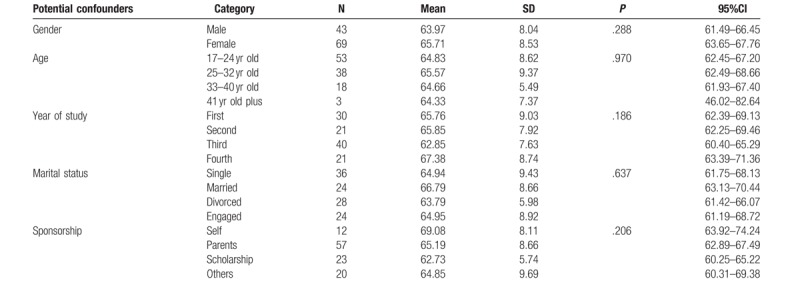
Table 3 shows the results of a 3-time assessment of educational technology students of the Nigerian universities on depression reduction using the Beck's Depression Inventory-II (BDI-II). Table 3 specifies that there was no significant difference between the treatment and usual-care control groups in initial Beck's Depression Inventory-II (BDI-II), with F (1111) = 0.107, P = .745,  . The students in both treatment and usual-care control groups had severe depression.
. The students in both treatment and usual-care control groups had severe depression.
Table 3.
Results on the efficacy of guided internet-assisted intervention for depression reduction by BDI-II.

The measure after the intervention using GIAI indicates a significant reduction in depression among the participants in the treatment group when compared to their counterparts in the usual-care control group, F (1111) = 254.56, P = .000,  . See Figure 2 for the graphical representation of the result.
. See Figure 2 for the graphical representation of the result.
Figure 2.
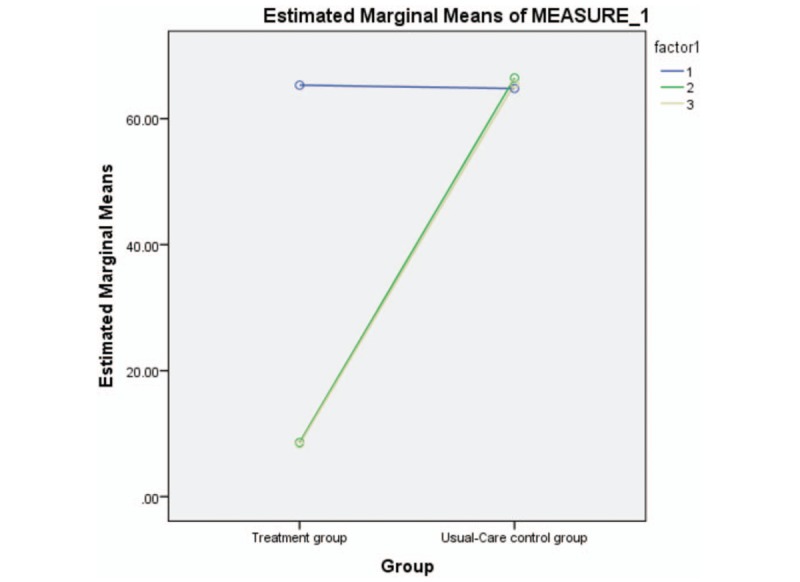
Graphical representation of results. This legend shows graphical presentation result.
Likewise, the follow-up measure (Time 3) showed that there was a significant reduction in depression among participants in the treatment group than those in the usual-care control group, F (1111) = 261.89, P = .000,  . See Figure 3 graphical representation of this result. Based on these results, we assert that GIAI was significantly efficacious in reducing depression.
. See Figure 3 graphical representation of this result. Based on these results, we assert that GIAI was significantly efficacious in reducing depression.
Figure 3.
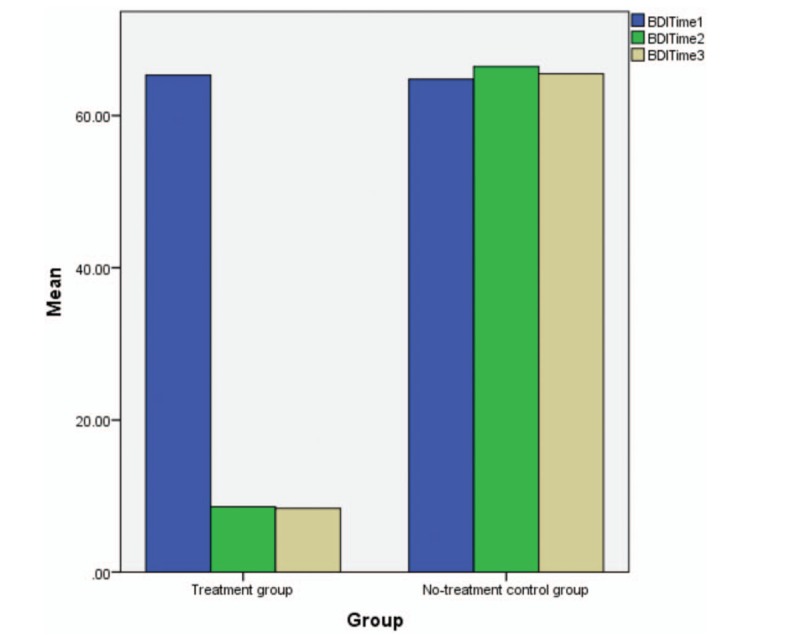
Bar chart. This legend shows the bar chart of the results.
4. Discussion
At the baseline measure, we found that there was a severe level of depression among participants in both treatment and usual-care control groups. This finding agrees with previous findings which indicate a high prevalence of depression among university students.[2,3,5–7] However, GIAI was efficacious in reducing the rate of depression among university students in the treatment group when compared to those in the usual-care control group. The efficacy of the intervention was significantly sustained in the treatment group at follow-up meetings. These current findings support the outcome of previous researches which confirmed that internet-based interventions guided by therapists are effective for depression treatment.[8,13,16,31]
Going by the previous assertion that depressed university students are reluctant to seek face-to-face intervention,[13] one may suggest that guided GIAI would give the university students ample opportunity to participate in depression intervention. Moreover, educational technology students may prefer internet intervention since it appears that the internet is part of their curriculum. Thus, GIAI principles should be adopted by depression therapists to perform depression treatment among university students. Coupled with the evidence that 96% of young people spend an average of 11 hours on the internet,[36] the use of GIAI for depression reduction will be effective among the university students who are mostly young people.
4.1. Implications
The findings of the study have implications for educational technology practice, counseling, psychotherapy, research, and policy. The GIAI is a key concept in the educational technology discipline that is charged with the responsibility of enhancing the quality of learning through the use of various instructional resources. Educational technologists are known by their ethical practice of facilitating educational interventions by creating, using, and managing appropriate technological processes and resources.[37,38] To confirm this claim, the present findings demonstrated that GIAI was effective in reducing depression among students. This implies that there is a need for an instructional resource like GIAI to be used extensively to help students solve health-related problems like depression.[39] Universities and other tertiary institutions should adopt a policy that permits the use of GIAI to perform medical and psychotherapeutic processes to enhance healthy living among the students. Also, medical and health practitioners and professionals should adopt GIAI for the management of depression in hospitals, health centers, medical schools, and university campuses. Based on the findings of the present study, it appears that the application of GIAI will increase the quality of medical practices and research.
4.2. Limitations
Though the present study generated significant positive findings, there are some notable limitations. The investigators acknowledge that the sample size included only educational technology students of Nigeria universities. Therefore, future studies should endeavor to cover other higher institutions in Southeast, Nigeria for probable generalization of findings to all tertiary education students in the country.
Another limitation is that the efficacy of GIAI was assessed using instrument which produced essentially quantitative data. Therefore, it is pertinent for future studies to also collect qualitative data via interviews, observation and the participants’ opinions to complement the findings based on quantitative data. Additionally, even though a follow-up assessment was conducted in this study, proper consideration for the long-term effect of GIAI may be required. To this end, it would be needful for future researches to focus on conducting long-term follow-up assessments to determine the possibility of maintaining an increase in depression reduction through GIAI.
Again, the use of the usual-care control group in the study made only the participants in the treatment group benefit from the GIAI, whereas those in the usual-care control group were disadvantaged. Therefore, it is needful for future investigators to provide participants under the control condition with the chance of having informal discussions after the intervention and follow-up activities. Lastly, the analysis of the data in the study did not consider demographic variables. Future researches should consider the moderating and mediating impact of some demographic variables.
5. Conclusion
The objective of this study was to determine the efficacy of GIAI on depression reduction among educational technology students of Nigerian universities. The study's findings indicated that GIAI was efficacious in reducing depression among participants in the treatment group when compared to those in the usual-care control group. Capturing from this finding, the investigators made a recommendation that GIAI be used across the universities in Nigeria and other countries for depression reduction among students. It is further recommended that educational technologists, counselors, psychologists, health workers, and other social workers with a satisfactory knowledge of GIAI should use this approach in helping students undergo depression reduction.
Acknowledgments
The authors acknowledged the previous researchers whose studies are cited in this work. The study participants, consultants, reviewers, and editors are appreciated for their contributions and scrutiny which helped to improve the standard of the study.
Author contributions
Conceptualization: Mkpoikanke Sunday Otu.
Formal analysis: Mkpoikanke Sunday Otu.
Funding acquisition: Theresa Onyema Ofoegbu, Uche Asogwa.
Investigation: Theresa Onyema Ofoegbu, Uche Asogwa, Mkpoikanke Sunday Otu.
Methodology: Uche Asogwa, Mkpoikanke Sunday Otu, Abdullahi Muhammed.
Project administration: Abdullahi Muhammed.
Resources: Theresa Onyema Ofoegbu, Christopher Ibenegbu, Abdullahi Muhammed.
Software: Theresa Onyema Ofoegbu.
Supervision: Theresa Onyema Ofoegbu, Christopher Ibenegbu, Ben Eze.
Validation: Mkpoikanke Sunday Otu, Christopher Ibenegbu, Abdullahi Muhammed, Ben Eze.
Visualization: Theresa Onyema Ofoegbu.
Writing – original draft: Theresa Onyema Ofoegbu, Ben Eze.
Writing – review & editing: Theresa Onyema Ofoegbu, Christopher Ibenegbu, Ben Eze.
Mkpoikanke Sunday Otu orcid: 0000-0002-7251-2561.
Footnotes
Abbreviations: BDI-II = Beck's Depression Inventory-II, GIAI = guided internet-assisted intervention.
How to cite this article: Ofoegbu TO, Asogwa U, Otu MS, Ibenegbu C, Muhammed A, Eze B. Efficacy of guided internet-assisted intervention on depression reduction among educational technology students of Nigerian universities. Medicine. 2020;99:6(e18774).
The authors have no conflicts of interest to disclose.
References
- [1].Ibrahim AK, Kelly SJ, Adams CE, et al. A systematic review of studies of depression prevalence in university students. J Psychiatr Res 2013;47:391–400. [DOI] [PubMed] [Google Scholar]
- [2].Dahlin M, Joneborg N, Runeson B. Stress and depression among medical students: a cross-sectional study. Med Educ 2005;39:594–604. [DOI] [PubMed] [Google Scholar]
- [3].Shamsuddin K, Fadzil F, Ismail WSW, et al. Correlates of depression, anxiety and stress among Malaysian university students. Asian J Psychiatr 2013;6:318–23. [DOI] [PubMed] [Google Scholar]
- [4].Nwefuru B, Otu M, Eseadi C. Stress, depression, burnout and anxiety among chemistry education students in Universities in South-East, Nigeria. J Consult Train Serv 2018;2:46–54. [Google Scholar]
- [5].Gureje O, Uwakwe R, Oladeji B, et al. Depression in adult Nigerians: results from the Nigerian Survey of Mental Health and Well-being. J Affect Disord 2010;120:158–64. [DOI] [PubMed] [Google Scholar]
- [6].Onyechi KCN, Eseadi C, Okere AU, et al. Effects of cognitive behavioral coaching on depressive symptoms in a sample of type 2 diabetic inpatients in Nigeria. Medicine 2016;95: [DOI] [PMC free article] [PubMed] [Google Scholar]
- [7].Tomlinson M, Swartz L, Kruger L-M, et al. Manifestations of affective disturbance in sub-Saharan Africa: key themes. J Affect Disord 2007;102:191–8. [DOI] [PubMed] [Google Scholar]
- [8].Karyotaki E, Ebert DD, Donkin L, et al. Does guided internet-based interventions result in clinically relevant changes for patients with depression? An individual participant data meta-analysis. Clin Psychol Rev 2018. [DOI] [PubMed] [Google Scholar]
- [9].Bayram N, Bilgel N. The prevalence and socio-demographic correlations of depression, anxiety and stress among a group of university students. Soc Psychiatry Psychiatr Epidemiol 2008;43:667–72. [DOI] [PubMed] [Google Scholar]
- [10].Wong JG, Cheung EP, Chan KK, et al. Web-based survey of depression, anxiety and stress in first-year tertiary education students in Hong Kong. Aust N Z J Psychiatr 2006;40:777–82. [DOI] [PubMed] [Google Scholar]
- [11].Bostanci M, Ozdel O, Oguzhanoglu NK, et al. Depressive symptomatology among university students in Denizli, Turkey: prevalence and sociodemographic correlates. Croat Med J 2005;46:96–100. [PubMed] [Google Scholar]
- [12].Eisenberg D, Gollust SE, Golberstein E, et al. Prevalence and correlates of depression, anxiety, and suicidality among university students. Am J Orthopsychiatr 2007;77:534–42. [DOI] [PubMed] [Google Scholar]
- [13].Schröder J, Berger T, Westermann S, et al. Internet interventions for depression: new developments. Dialogues Clin Neurosci 2016;18:203. [DOI] [PMC free article] [PubMed] [Google Scholar]
- [14].Bruckner TA, Scheffler RM, Shen G, et al. The mental health workforce gap in low-and middle-income countries: a needs-based approach. Bull World Health Organ 2011;89:184–94. [DOI] [PMC free article] [PubMed] [Google Scholar]
- [15].Wang PS, Berglund P, Olfson M, et al. Failure and delay in initial treatment contact after first onset of mental disorders in the National Comorbidity Survey Replication. Arch Gen Psychiatr 2005;62:603–13. [DOI] [PubMed] [Google Scholar]
- [16].Kazdin AE, Blase SL. Interventions and models of their delivery to reduce the burden of mental illness: reply to commentaries. Perspect Psychol Sci 2011;6:507–10. [DOI] [PubMed] [Google Scholar]
- [17].2012;Aluede O, Idogho O, Imonikhe JS. Increasing access to university education in Nigeria: present challenges and suggestions for the future. The African Symposium. [Google Scholar]
- [18].Eom SB, Wen HJ, Ashill N. The determinants of students’ perceived learning outcomes and satisfaction in university online education: an empirical investigation. Decis Sci J Innov Educ 2006;4:215–35. [Google Scholar]
- [19].Frehywot S, Vovides Y, Talib Z, et al. E-learning in medical education in resource constrained low-and middle-income countries. Hum Resour Health 2013;11:4. [DOI] [PMC free article] [PubMed] [Google Scholar]
- [20].Steer RA, Rissmiller DJ, Beck AT. Use of the Beck Depression Inventory-II with depressed geriatric inpatients. Behav Res Ther 2000;38:311–8. [DOI] [PubMed] [Google Scholar]
- [21].Beck AT, Steer RA, Ball R, et al. Comparison of Beck Depression Inventories-IA and -II in psychiatric outpatients. J Pers Assess 1996;67:588–97. [DOI] [PubMed] [Google Scholar]
- [22].David D, Kangas M, Schnur J, et al. REBT Depression Manual: Managing Depression Using Rational Emotive Behavior Therapy. Romania: Babes-Bolyai University; 2004. [Google Scholar]
- [23].Farrer L, Christensen H, Griffiths KM, et al. Internet-based CBT for depression with and without telephone tracking in a national helpline: randomised controlled trial. PloS One 2011;6:e28099. [DOI] [PMC free article] [PubMed] [Google Scholar]
- [24].Johansson R, Andersson G, Ebmeier, et al. Internet-based psychological treatments for depression. Expert Rev Neurother 2012;12:861–70. [DOI] [PubMed] [Google Scholar]
- [25].Bukhsh A, Nawaz MS, Ahmed HS, et al. A randomized controlled study to evaluate the effect of pharmacist-led educational intervention on glycemic control, self-care activities and disease knowledge among type 2 diabetes patients: a consort compliant study protocol. Medicine 2018;97: [DOI] [PMC free article] [PubMed] [Google Scholar]
- [26].Lee J-H, Schell MJ, Roetzheim R. Analysis of group randomized trials with multiple binary endpoints and small number of groups. PloS One 2009;4:e7265. [DOI] [PMC free article] [PubMed] [Google Scholar]
- [27].Proudfoot J, Klein B, Barak A, et al. Establishing guidelines for executing and reporting internet intervention research. Cogn Behav Ther 2011;40:82–97. [DOI] [PubMed] [Google Scholar]
- [28].Faul F, Erdfelder E, Buchner A, et al. G∗ Power Version 3.1. 7 [computer software]. Germany: Uiversität Kiel; 2013. [Google Scholar]
- [29].Beck AT, Steer RA, Brown GK. Beck Depression Inventory-II. San Antonio. Vol. 78. 1996;490–498. [Google Scholar]
- [30].Saghaei M. Random allocation software for parallel group randomized trials. BMC Med Res Methodol 2004;4:26. [DOI] [PMC free article] [PubMed] [Google Scholar]
- [31].Ander M, Wikman A, Ljótsson B, et al. Guided internet-administered self-help to reduce symptoms of anxiety and depression among adolescents and young adults diagnosed with cancer during adolescence (U-CARE: YoungCan): a study protocol for a feasibility trial. BMJ Open 2017;7:e013906. [DOI] [PMC free article] [PubMed] [Google Scholar]
- [32].Gilbody S, Whitty P, Grimshaw J, et al. Educational and organizational interventions to improve the management of depression in primary care: a systematic review. JAMA 2003;289:3145–51. [DOI] [PubMed] [Google Scholar]
- [33].Bakker P, Sádaba C. The impact of the internet on users. The Internet and the Mass Media 2008;86–101. [Google Scholar]
- [34].IBM Corp N. IBM SPSS statistics for windows. Version 220, 2013. [Google Scholar]
- [35].Otu MS. The effect of computer-mediated parental health guidance on risky sexual behaviors of in-school adolescents in Nigeria. J Consult Train Serv 2018;2:10–6. [Google Scholar]
- [36].Hamid F, HI AR, Morissan M. Anti-sosial Pengguna Media Sosial Di Kalangan Generasi Muda. Jurnal Ilmu Ekonomi dan Sosial 2015;4:50–66. [Google Scholar]
- [37].Reiser RA. What field did you say you were in. Trends and Issues in Instructional Design and Technology 2007;2–9. [Google Scholar]
- [38].Earle RS. The integration of instructional technology into public education: promises and challenges. Educ Technol 2002;42:5–13. [Google Scholar]
- [39].Saiful JA. EFL teachers’ cognition in the use of Youtube Vlog in English language teaching. J Foreign Lang Educ Technol 2019;4:1. [Google Scholar]


